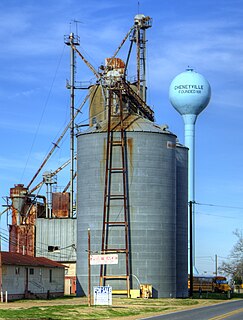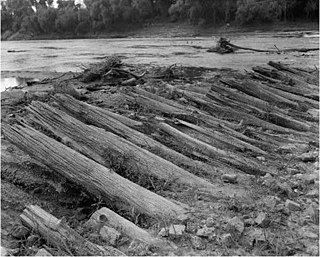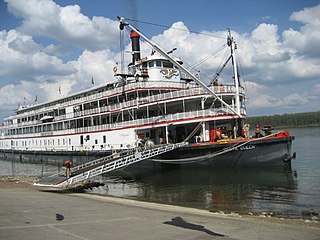| Locale | Louisiana |
|---|---|
| Dates of operation | 1837 [1] –1881 |
| Successor | New Orleans Pacific Railway |
| Track gauge | 5 ft (1,524 mm) |
| Headquarters | Alexandria, LA |
The Red River Railroad, also known as the Ralph Smith Smith Railroad and the Alexandria and Cheneyville Railroad, was the first railroad in the United States built west of the Mississippi River.

The Mississippi River is the second-longest river and chief river of the second-largest drainage system on the North American continent, second only to the Hudson Bay drainage system. Its source is Lake Itasca in northern Minnesota and it flows generally south for 2,320 miles (3,730 km) to the Mississippi River Delta in the Gulf of Mexico. With its many tributaries, the Mississippi's watershed drains all or parts of 32 U.S. states and two Canadian provinces between the Rocky and Appalachian mountains. The main stem is entirely within the United States; the total drainage basin is 1,151,000 sq mi (2,980,000 km2), of which only about one percent is in Canada. The Mississippi ranks as the fourth-longest and fifteenth-largest river by discharge in the world. The river either borders or passes through the states of Minnesota, Wisconsin, Iowa, Illinois, Missouri, Kentucky, Tennessee, Arkansas, Mississippi, and Louisiana.
An area engineer, planter and steamboat operator, Ralph Smith Smith, developed 16 miles (26 km) of 5 ft (1,524 mm) [2] gauge railroad line to connect Smith's Landing at Lecompte, Louisiana to the docks at Alexandria, Louisiana, enabling area settlers to have greater opportunity to get their crops to market. Although slow and crudely built, the train was capable of making one round trip daily. [3] Smith Smith also owned three steam boats with which he transported cotton brought to Alexandria on the railroad to New Orleans.

Railways with a railway track gauge of 5 ft were first constructed in the United Kingdom and the United States. This gauge is also commonly called Russian gauge because this gauge was later chosen as the common track gauge for the Russian Empire and its neighbouring countries. The gauge was redefined by Soviet Railways to be 1,520 mm.

In rail transport, track gauge or track gage is the spacing of the rails on a railway track and is measured between the inner faces of the load-bearing rails.

Lecompte is a town in Rapides Parish, Louisiana, United States. It is part of the Alexandria, Louisiana Metropolitan Statistical Area. The population was 1,366 at the 2000 census.
When completed, the line of railroad extended approximately 40 miles (64 km) between Alexandria, Louisiana and Bayou Hauffpaur near Cheneyville, Louisiana. [1] The railroad transported sugar cane and cotton in connection with steamboats on the Red River. [1]

Cheneyville is a town in Rapides Parish, Louisiana, United States. It is part of the Alexandria, Louisiana Metropolitan Statistical Area. The population was 901 at the 2000 census.
The railroad operated for over twenty years. It was destroyed in 1864 during the Red River Campaign of the American Civil War when Union soldiers used rails, cross ties, bridge timbers, and rolling stock from the railroad as material to dump into the Red River in the construction of Bailey's Dam. [1] [4] The car house in Alexandria was burned when the town was destroyed by retreating Union forces on May 13, 1864. [5]

The Red River Campaign or Red River Expedition comprised a series of battles fought along the Red River in Louisiana during the American Civil War from March 10 to May 22, 1864. The campaign was a Union initiative, fought between approximately 30,000 Union troops under the command of Major General Nathaniel P. Banks, and Confederate troops under the command of Lieutenant General Richard Taylor, whose strength varied from 6,000 to 15,000.

The American Civil War was a civil war fought in the United States from 1861 to 1865, between the North and the South. The most studied and written about episode in U.S. history, the Civil War began primarily as a result of the long-standing controversy over the enslavement of black people. War broke out in April 1861 when secessionist forces attacked Fort Sumter in South Carolina shortly after Abraham Lincoln had been inaugurated as the President of the United States. The loyalists of the Union in the North proclaimed support for the Constitution. They faced secessionists of the Confederate States in the South, who advocated for states' rights to uphold slavery.

Bailey's Dam was a timber dam on the Red River in Alexandria, Louisiana. The dam was built in 1864 at Lieutenant Colonel Joseph Bailey's request to afford passage over the Alexandria rapids for part of Rear Admiral David Dixon Porter's Mississippi River Squadron during the Red River Campaign in the Civil War. The dam successfully raised the level of the river and was then breached in order to allow the boats in its reservoir to pass downstream.
In 1881, the railroad was sold to the New Orleans Pacific Railway Company. [3] [6]













